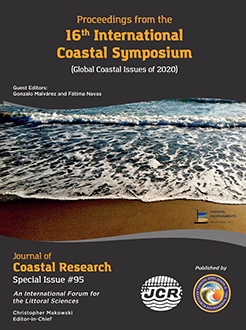Silva, A.; Taborda, R.; Castelle, B., and Dodet, G., 2020. Wave directional spreading importance on sheltered embayed beaches. In: Malvárez, G. and Navas, F. (eds.), Global Coastal Issues of 2020. Journal of Coastal Research, Special Issue No. 95, pp. 1536–1541. Coconut Creek (Florida), ISSN 0749-0208.
It is widely recognized that the planimetric configuration of headland-bay beaches depends on the direction of wave approach. However, the influence of the wave directional spreading on beach planform is largely unknown, as it is also unknown to what extent dominant swell refraction is more (or less) relevant than secondary, less energetic, components of wave spectra, on embayed beach configuration. This study presents a conceptual investigation on the importance of the directional wave spectra by simulating the wave propagation, of a double-peaked sea state, along sites with contrasting wave exposure, and by comparing a simulation using the full wave spectrum (SPEC) with a simulation that only uses the parametric wave characteristics (PARAM) as boundary wave conditions. The results show that the frequency-direction energy distribution is critical to nearshore wave conditions of sheltered beaches. Wave energy estimates are 40% to 55% higher when considering SPEC over PARAM simulations. Moreover, for this doubled-peaked sea sate, the south facing beaches show an exposure to wind-waves from the S, 1.8 to 2 times higher than to the swell from the W. For the Portuguese coast, that is subject to a mixture of S waves during “Mar de Sudoeste” events with dominant NW to W swells, as well for any coast exposed to a bimodal wave climate, accounting for the full frequency-direction spectra is therefore of great importance to further understand and predict coastal change.





